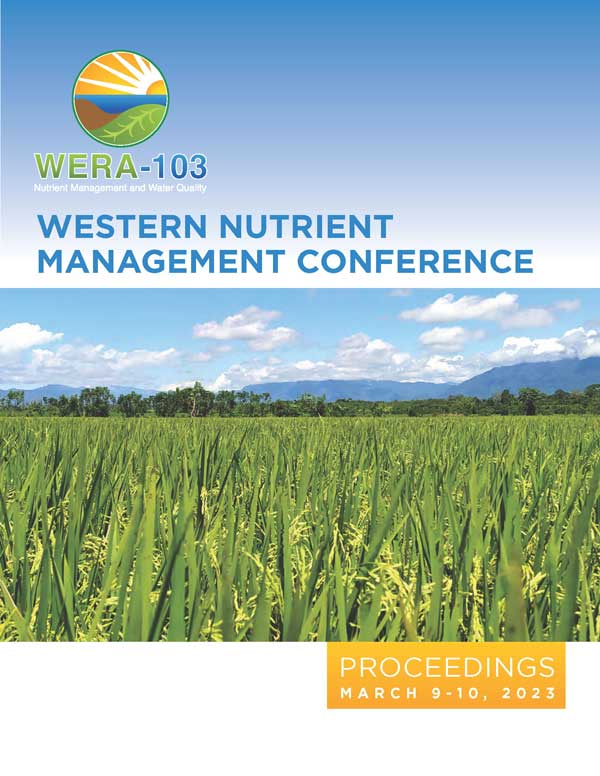Download the Conference Proceedings
Proceedings
Topics
| Filter results8 paper(s) found. |
|---|
1. Economics of Alfalfa Fertilization Under Inflated Hay and Fertilizer PricesKnowing critical alfalfa nutrient levels in-season improves recommendations and applications, while at the same time saves producers time, expense and effort since many growers take samples for hay quality. Inflation has doubled hay and fertilizer prices which brings into question how current fertility decisions are made. From 2019-2020 detail information on phosphorus and potassium response was conducted. Two experiments were designed as follows: 1) Phosphorus (P) rate study with diffe... S. Norberg, D. Llewellyn, J.P. Driver, S. Fransen, J. Harrison |
2. Variable Rate Fertilization: Soil Moisture ImpactsVariable Rate Fertilization (VRF) fertilization is a means of potentially applying nutrients more efficiently. Variable Rate Irrigation (VRI) is increasingly evaluated. However, these are generally studied in isolation, which seems contrary to the principles on which each are founded. Potential benefits of VRF, especially for N, are often confounded or repressed as a result of soil moisture variability due to runoff losses/accumulation and/or total water applied. Similarly, VRI results are im... B.G. Hopkins |
3. Spoon-fed Nitrogen and Phosphorus Management for Subsurface Drip Irrigated Cotton (Gossypium hirsutum)Subsurface drip irrigation (SDI) is becoming a popular option for maximizing the water use efficiency of cotton (Gossypium hirsutum), especially in semi-arid environments of the Midsouth and Western United States. Applying fertilizers through SDI provides an opportunity to prescriptively apply nutrients at peak nutrient demand which could minimize loss and increase uptake, but the application timing is poorly understood. The objective of this study was to develop nitrogen (N) an... J.A. Burke, K.L. Lewis |
4. Performance of Public and Private Fertilizer Recommendations for Corn, Alfalfa, and Small GrainsThere are many sources that growers utilize to determine fertilizer needs for crops such as private and public labs, crop advisors, and fertilizer dealers. In many cases, these sources provide recommendations for a specific crop that can vary greatly, and the resulting fertilizer and application rates recommended can lead to large differences in costs for the grower. Evaluating the effectiveness and economics of current fertilizer guidelines and recommendations will help growers to make bette... M. Yost, M. Baker, J. Gale, E. Creech, G. Cardon |
5. Stacking 4R Nutrient Management: PotatoThe 4Rs of nutrient management are research-based guidelines with the aim to improve the sustainability of major cropping systems and the environment without compromising crop yield and quality. The term “4R” represents fertilizer applied at the Right rate with the Right source, Right timing, and Right placement. The objective of this project is to evaluate the interactions of individual and combined 4R management practices. In 2020, potato (Solanum tuberosum L.) was grow... S.H. Stapley, C.C. Whitaker, N.C. Hansen, R.C. Christensen, R.R. Jensen, M.A. Yost, B.G. Hopkins |
6. Nitrogen Fertilizer Rate and Timing Implications for Malt, Food, and Feed Barley Production in Southern IdahoNitrogen is an essential nutrient required to produce high-yielding barley. Nitrogen strongly impacts barley yield, grain protein, tillering, and lodging potential. Unlike other crops such as corn, available nitrogen must be carefully managed for producers to achieve both optimal yield and grain quality for malt, food, and feed barley. Exessive nitrogen availability increases grain protein concentration that may be unsuitable for malting but may be ideal for feed or food barley. The objective... J. Spackman, O. Walsh, A. Adjesiwor, O. Adeyemi, J. Sagers, R. Findlay, J. Bevan |
7. Crystal Green® – the Most Efficient Granular Phosphate FertilizerOver 80% of applied conventional phosphate can be lost to soil fixation or the environment and leaves crops hungry for nutrients when they need them the most. Overapplying conventional phosphate fertilizers, produced from a finite resource, to overcome significant inefficiencies does not align well with industry goals of sustainability. Not only are crops missing out on proper plant nutrition of a critical nutrient, these nutrients are lost to the environment and are responsible for harmful a... G. Mooso |
8. Variable Rate N and P Management for High-value Vegetable Cropping SystemsThe Lower Colorado River Region (LCRR) of Arizona and California and their environs produce more than 90% of the nation’s cool season vegetables during the fall-winter-spring period. Large amounts of N and P fertilizers are currently utilized for maximum yield and quality. Phosphorus fertilizers are applied pre-plant based on a soil test of a composite field sample. Nitrogen is applied by side-dress based on a plant midrib or petiole N analysis, or soil nitrate-N test, from ... C.A. Sanchez, P. Andrade |
